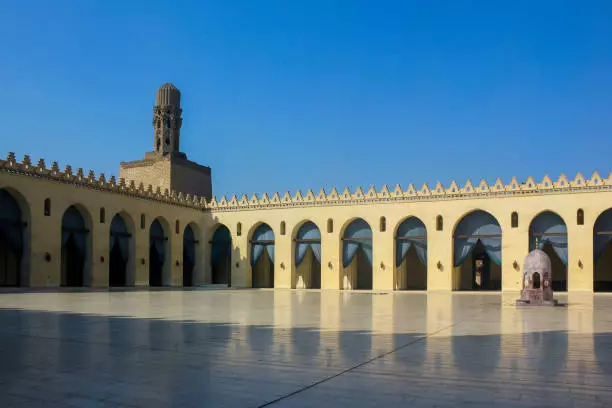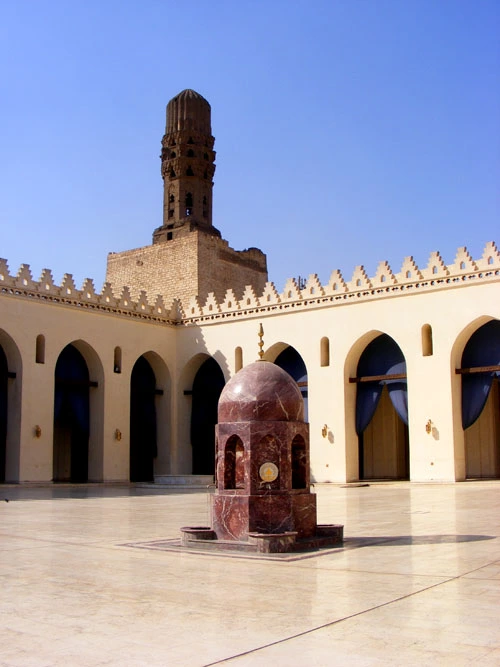The Mosque Of Al Hakim
Egypt is particularly famous for its diversity and multitude of Islamic monuments built through different eras. The building of Islamic monuments in Egypt began when the Moslems opened in Egypt in 641 AD.
From this point on, Egypt was ruled by many Islamic dynasties, starting with the "Rashdin Caliphs, "the Tulunids, the Fatimids, the Ayyubids, the Mamluks, and the Ottomans, and ending with rulers from the family of Mohamed Ali.
The requirements and characteristics of each period were reflected in the architecture's shape, size, and style. Moreover, each ruler tried his best to build structures that expressed the features of his period.

Among the most famous Islamic monuments in Egypt are the Mosque of Mohamed Ali in the citadel of Salah El Din, the Madrasa of Sultan Hassan, the Mosque of Ahmed Ibn Tulun, The mosque of Al Azhar, and the Mosque of Amr Ibn Al-As, the oldest mosque ever built in Egypt and Africa. It's one of the oldest Islamic monuments in Egypt, and its builder, Al-Hakim, was one of the most famous Caliphs who ever ruled Egypt.
However, tourists and even Egyptians sometimes miss many other impressive Islamic monuments in Egypt because they are unaware of them. Some of these monuments are unique, picturesque, and built on a vast area.
One of the best examples of these remarkable monuments is the Mosque of Al-Hakim Be'amr Allah.
The Mosque of Al-Hakim is located at the end of Al Muiz Street, very close to Bab El Fetooh, one of Egypt's ancient gates. It is also near the famous Khan El Khalili market. Therefore, it is always a good idea to explore the monuments on Muiz Street after visiting the world's most renowned tourist market. Since Cairo once only consisted of this narrow street and the areas around it, it contains various Islamic monuments.
Al-Hakim and his advocacy for the new religion:
Construction of the ancient Mosque of Al-Hakim started in 990 AD with a decision from the Fatimid Caliph, "Al Aziz be Allah Ibn Al Muiz le Din Allah," and the mosque was completed in 1012 during the reign of Al-Hakim Be'amr Allah, the third Fatimid ruler in Egypt.
Many rumors and debates surround Al-Hakim, his ideas, and the period of his rule. Al-Hakim came to power when he was only 11, and he successfully formed a plan to assassinate his tutor when he was 15. It was said that he burned many places in Cairo when people refused to obey some of his weird laws, like replacing his name with the name of God, Allah, in the prayers. He also hated mallow, the Egyptian Molokhia, so he forbids people from eating it despite it being one of the most popular dishes. He also prohibited shoemakers from manufacturing shoes for women as he believed they should stay home, and it was also debated that he once ordered his men to throw all of Egypt's molasses production into the river Nile, and many other stories and rumors.

The weirdest and most serious story about Al-Hakim was that he used to go to a cave in Al Moqatem mountain and stay alone for long hours. One night, he claimed that he heard a voice telling him that he should unite both religions, Islam and Christianity, to become one new unified religion. These ideas entered his head because his father was the founder of the Fatimid Shiite doctrine, and at the same time, his mother was the sister of the Patriarch of the Copts in Egypt at the time.
The theory of Al-Hakim depends on the notion that there is only one god, so why don't we have only one religion? Why shouldn't we have only one prophet, and why shouldn't he, Al-Hakim, become this prophet?
When Al-Hakim started planning how to spread the message of this new religion, he didn't know the conspiracy that was taking place around him. With the help of the army commander, Seif El Din Ibn Rawash, one of the royal family ladies was participating in it. They decided to assassinate him before he could spread the poison of this new religion among the people of Egypt, taking into account that the Fatimids were Shiites and very conservative towards their Islamic beliefs and thoughts.
One night, while Al-Hakim was riding his donkey and going to his cave, a group of strong enslaved people attacked and killed him, and his body wasn't found until today. This was the last event in the life of one of the strongest rulers of Egypt.
Although many historical theories support the above facts, people were still determining what was inside Al-Hakim's head. Was he a cruel ruler, or did his assassins spread these rumors to ruin his reputation? The only absolute fact about Al-Hakim is his mosque, which is still present in Egypt today.
The architectural description of the Mosque:
The Mosque of Al-Hakim is the second largest Fatimid Mosque in Egypt, and it's designed similarly to that of the Mosque of Ahmed Ibn Toulon. The Mosque was primarily built from brick, except for the two unique minarets. These were constructed out of stone. The Mosque has an open courtyard, "Sahn," with four halls, "Riwaq," surrounding it from four directions. The most prominent and beautiful among them is the Qibla Riwaq, which identifies the direction to Mecca, which Muslims should face while praying.
The Mosque of Al-Hakim is famous for three main architectural characteristics. The first is the memorial entrance, with its vast size and fabulous decorations. This entrance is the first of its kind to be built in Egypt, and there aren't any other mosque entrances that can be compared to it except the one of Al Mahdeya Mosque in Tunisia.
The second beautiful architectural aspect of this Mosque is the broad white marble floor that reflects the Mosque itself from the inside. Birds flock around the Mosque and stand on its unique floor as they drink water from its fountain.
Al-Hakim mosque's third and most unparalleled feature is its uniquely designed two minarets located at the north and south corners of its western entrance. They are the oldest surviving minarets in Egypt. Furthermore, Egypt would look like the Hakim Mosque because of its rare design imported to Egypt, North Africa, the origin of the Fatimids.
The minarets were built by dropping them inside two immense square stone structures that appear clearly from outside the Mosque. This was how the Fatimids made their minarets in Tunisia and North Africa.

The northern minaret is 33.7 meters long and topped by a cylindrical body. Above it lies a "Mabkhra"- style head, a very famous design in the days of the Fatimids. Meanwhile, the other minaret is 24.7 meters long, with an octagonal body above it and the "Mabkhra" head at the end.
The bases of these two minarets are original. However, the tops of the minarets were changed by Baybars Al Jashnkeer in 1303 when an earthquake hit Egypt and caused significant damage to the mosque. Baybars also added the wonderful Mihrab of the mosque, built out of colored marble.
The mosque would also appear similar to the Azhar Mosque in some factors: they both have this curve in the walls of the prayer halls, except that the Al-Hakim Mosque is much higher. Both mosques also share three small domes in the Qibla prayer hall.
The usage of the mosque through history:
Because of its vast space, the Mosque of Al-Hakim was not always used as a mosque or a prayer area; it was used for many other purposes throughout history.
The Mosque of Al-Hakim was used as a prison for the Crusaders, a horse stable during Salah El Din's reign, and a storage area for food and weapons during Napoleon Bonaparte's occupation of Egypt.
At the end of the French occupation, the French soldiers left the mosque in a deplorable state. The Mosque of Al-Hakim was not renovated until the period of Caliph Tawfiq when he decided to transform the mosque into an Islamic art museum before the museum was established in Port Said Street.
The Ismaili Shiites have also played a significant role in repairing and restoring the mosque by adding the remarkable marble floor and many other architectural aspects, especially ornamenting the mosque's walls with plaster decorations.
It must also be noted that the Indian Bohra Shiites are credited with all the modern restoration of the Mosque of Al-Hakim, resulting in its current appearance.
The Mosque of Al-Hakim was even used as a school in the times of the former Egyptian president, Gamal Abdel Nasser.
Today, the mosque receives numerous visitors worldwide who view the fascinating ancient Islamic architecture. The mosque is also still used for prayer.














